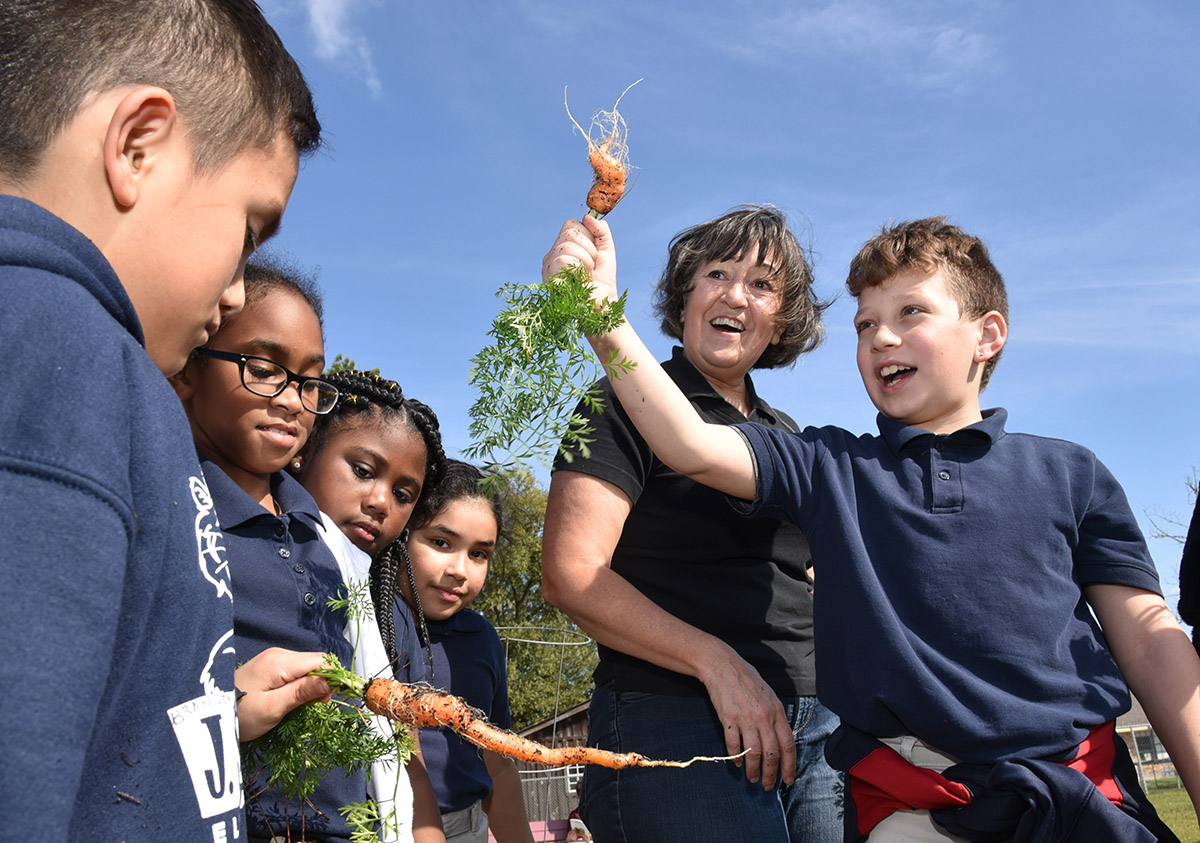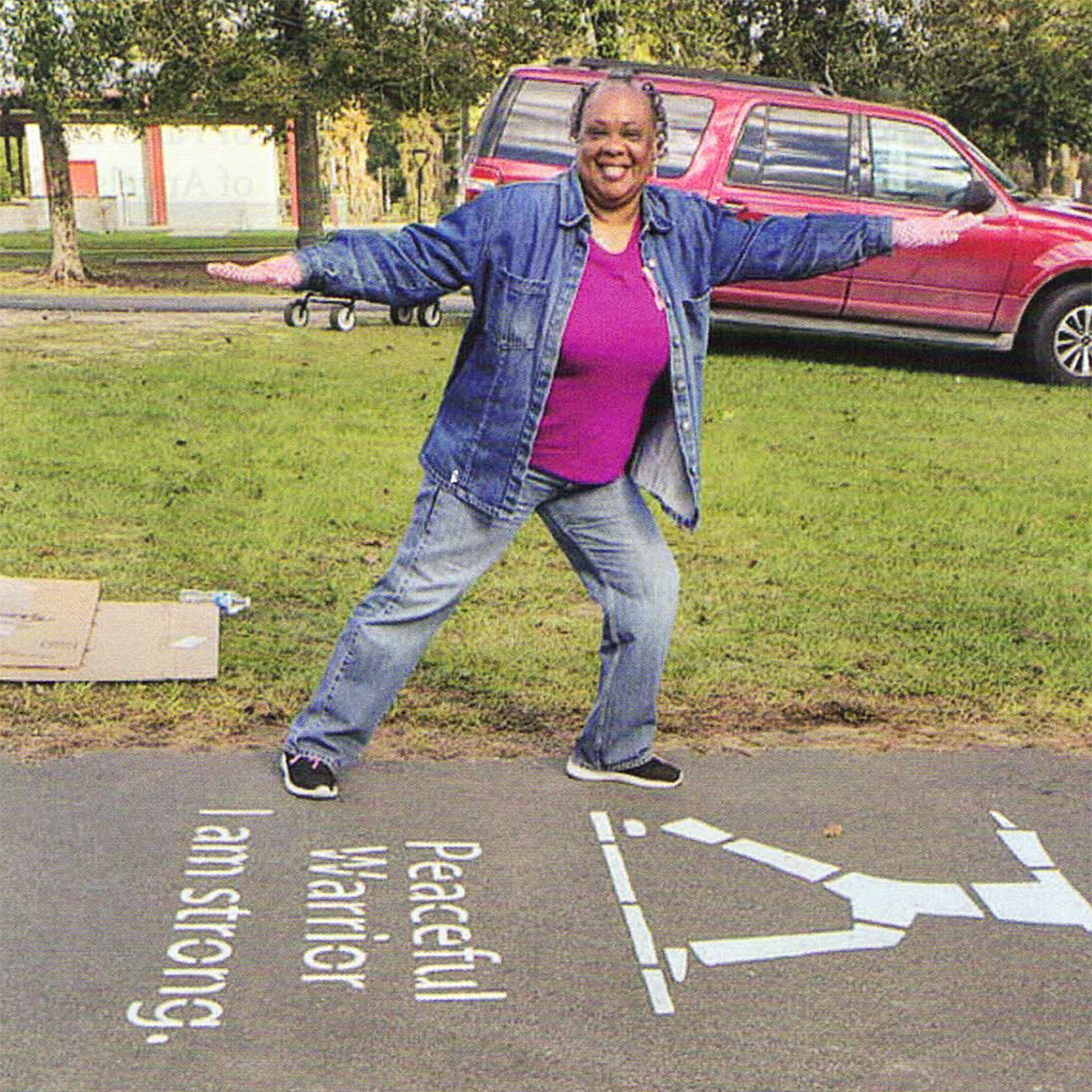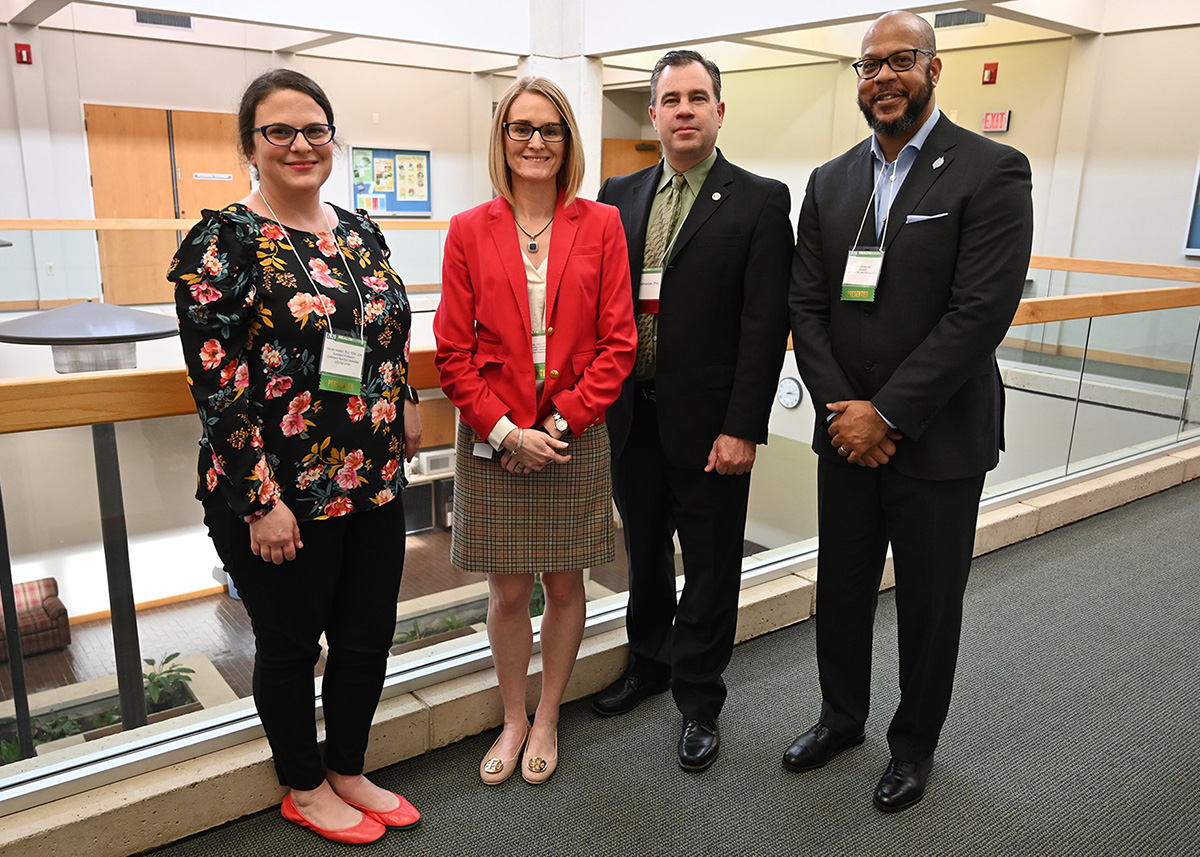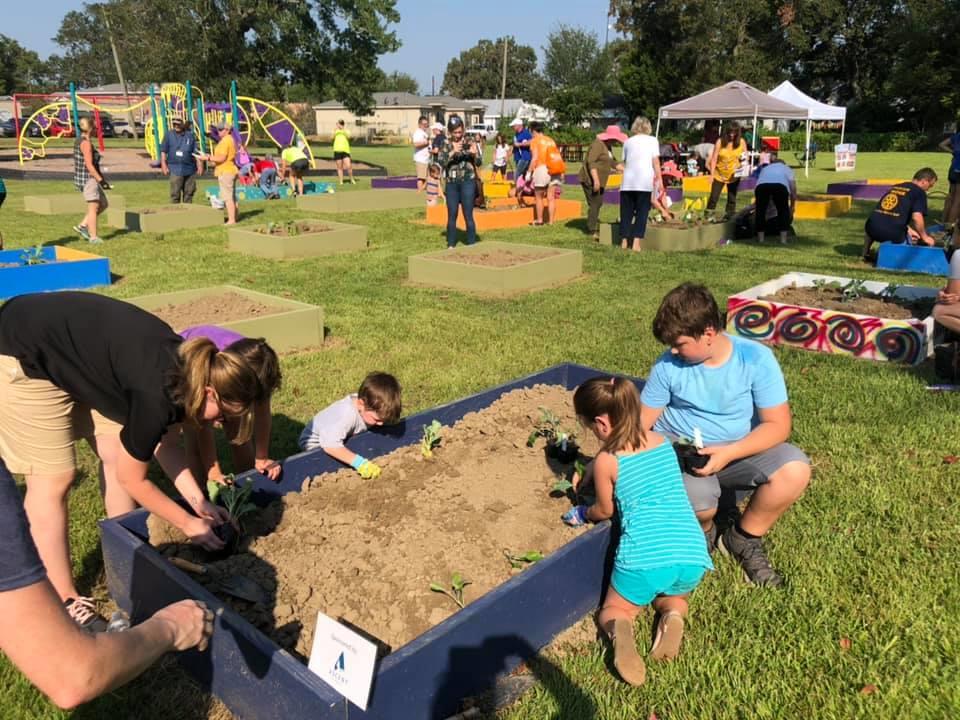For Healthy Communities, Knowledge Isn’t Enough
Through the Healthy Communities initiative, led by Denise Holston, assistant professor in the LSU School of Nutrition and Food Sciences, LSU AgCenter extension agents are on the ground in every Louisiana parish inviting residents to decide for themselves how to best lower obesity rates where they live—because knowledge, Holston says, isn’t enough.

Denise Mayon and children at the J.S. Aucoin Elementary School in Amelia, Louisiana,
show off carrots they harvested in the school garden that LSU AgCenter extension agent
Jessica Randazzo helped create.
Bruce Schultz/LSU AgCenter
Healthy Communities is an umbrella for several federally funded programs, including the Centers for Disease Control and Prevention’s High Obesity Program, or HOP (in six Louisiana parishes), the Expanded Food Nutrition Education Program, or EFNEP (in 10 Louisiana parishes), Flavors of Health (in 21 Louisiana parishes), and the SNAP-Ed program (in 39 Louisiana parishes).
So, why isn’t knowledge enough?
Community-based obesity prevention and intervention research, as well as nutrition
education in general, have always been very prescriptive: I need you to do this, this,
and this—and then we’re going to come test you afterward to see if any of your outcomes
have changed. But those efforts have not been shown to create sustainable change.
Federally funded programs, such as SNAP-Ed, EFNEP, and the CDC High Obesity Program,
have historically focused on nutrition education, too, but now there’s a move suggesting
that people can have knowledge regarding what to consume or do to be healthy but—in
some urban areas, and especially in rural areas—it isn’t enough. This is because we
need new policies, systems, and environmental changes (what we call PSEs) to ultimately
increase access to healthy foods and access to safe places for physical activity.
Tell me more.
It’s because the environment and the system people live in don’t necessarily make
it conducive for the healthy choice to be the easy choice. And we know that if the
healthy choice isn’t the easy choice, people will stay with their current behavior
and not change.
Can you describe some of the challenges?
In some parishes in Louisiana, you might be surprised to learn that people do not
have affordable access to healthy foods such as fruit and vegetables. The people in
these communities have told us they don’t have clean water to drink. They have brown
water coming out of the tap, and those who have issues with that have to spend some
of their food budget dollars on drinking water. In terms of physical activity, rural
communities don’t always have leash laws, so there can be dogs all over the place.
There are just a lot of issues going on, such as lack of crosswalks, sidewalks, or
even curbs, that almost make it impossible for people to eat healthy and be physically
active. It’s not just about “eat less and move more.”

Signage in stores as well as on roads and in local parks has been an affordable and effective way to increase the visibility of healthy options that already exist in each community, make it safer to walk and move around, and inspire activity, as shown here in Goodyear Park in Bogalusa where LSU worked together with community members to identify their needs and make improvements.
Photo courtesy of Denise Holston
How does your program work?
The AgCenter has offices in every parish in the state, so we take the research and
the best evidence and design programs that our agents can implement in their communities
in ways that are meaningful and relevant to each community. We also work with community
coalitions to prioritize and plan interventions. We’ll have local leadership, like
jurors, mayors, the local health department, restaurants, retailers, and community
members look at the assets and challenges in the community because no matter how poor
a community is, they always have assets. Then they prioritize what would be the best
fit in terms of improving healthy food access or places to be physically active.
Can you describe some of the interventions?
The interventions can be very different in every parish. Is it establishing a farmer’s
market? Improving their emergency food access, like a food pantry? Providing technical
assistance to local retailers and farmers so they can accept SNAP benefits and WIC
vouchers? Sometimes, we help local stores market the healthy choices they do have,
making them more visible and accessible to customers. Also, we might put crosswalks
down in areas where commuting to destinations is feasible. It’s all about connecting
everyday destinations. Sometimes people go to pay all of their bills at the courthouse,
so we’re going to make sure the walkways there are accessible, aesthetically pleasing,
and have shade, so people are encouraged to walk and not drive right up to the door.
You don’t need 60 minutes on the elliptical machine to be physically active. You need
to reduce sedentary behaviors and walk more throughout the day—that’s something a
lot of people should be able to do and not give up on.
It’s important to find the real barriers to people being more physically active. Maybe
there are no sidewalks at all, or maybe they’re unlevel. Signage can be important—and
slowing down traffic. In a lot of these rural areas, we have log trucks that speed
through, and it can be very dangerous to try to cross the street. Maybe you have to
work on reducing crime in a local park, so people aren’t afraid to go there. We talk
a lot about their sense of security.
How you do you make a program like this sustainable?
Since our agents work with communities to identify what residents think they need,
they usually get behind it and pool their resources and support the effort, and that
makes it much more likely to be sustainable over time.
But sometimes, people get so used to how things are. They don’t think about how things
could be. When you ask a community coalition what they’d like to see changed, it can
be really hard for them to articulate that, so we give them examples that are relevant
to the type of community they live in—rural, small, and so on. We also work with gatekeepers
and stakeholders so they understand what changes they can make and how everyone, the
whole community, can benefit.
There can be a lot of pressure for researchers, particularly for those of us in tenure-track
positions, to turn around research studies quickly in order to get out more publications.
And here I am, doing what is arguably some of the slowest research possible—community-based,
participatory research where the communities are part of the entire process: decision-making,
planning, implementing, and sometimes even evaluating. That slows things down, but
once everyone’s invested, it’s much more sustainable, too—that’s where the magic happens.
Once you get a community together around an idea, or in this case an intervention
that will create a pathway for access… it gives me goosebumps.

Denise Holston (left) leads the Healthy Communities initiative and presented on rural food access at the 2020 Health Access conference.
Photo courtesy of Denise Holston
Tell me more about food access.
So, what some people might not realize is that food insecurity goes hand in hand with
obesity. I often hear said that if people are poor, they shouldn’t have money to eat,
so they can’t be obese. But that’s not it. What they can’t afford is food that is
healthy—fresh fruits and vegetables, lean meats, and low-fat dairy. Also, transportation
is a big problem in rural areas. In most rural areas, there is no public transportation.
People without reliable transportation often have to pay to get out of their parish
to go grocery shopping, for example. That trip is costing them anywhere between $20
and $40, and they have to pay that to get access to the larger stores with cheaper
prices and perceived higher quality foods. But how does that balance out? It doesn’t,
not always.
Once you’re running out of money or food benefits, you’re also going to buy the thing
that’s the cheapest, and the cheapest things that can feed a whole family are often
not nutrient-dense, and not healthy. Our food-insecure people are looking for calories
to make sure their food dollars stretch throughout the month. And if the store that
has produce is far away and you don’t have a working refrigerator or freezer, you
have no way to store it or store large amounts of food purchased when and where prices
are cheapest, like at sales.
What is so amazing about this program, however, is that almost every community has
been able to come up with something that’s been helpful and meaningful to them and
the people who live there.
Can you give me a concrete example?
One of our most successful Healthy Communities Project so far is in Houma in Terrebonne
Parish. We held a community forum there in January last year where community members graded
their own health as a D, citing reasons such as poverty, low access to healthy food
items, and the general food culture. According to County Health Rankings, Terrebonne
Parish has an obesity rate of 39 percent and a food insecurity rate of 14 percent,
higher than the state average.
To help solve this problem, participants at the forum decided that a community garden
was the best way to improve access to affordable fresh produce. Live Healthy Houma,
an action-oriented workgroup facilitated by the LSU AgCenter, formed as a result and
together we pin-pointed an underutilized park in a low-income neighborhood. After
receiving permission from the recreation district, a total of 25 raised garden beds
were built and filled with plants; vegetables and herbs.

Harmon Park in Houma, Louisiana hosts a Healthy Communities community garden project that has brought together residents, local leadership, stores, clubs, and organizations to improve healthy food access and education for all.
Photo courtesy of Denise Holston
The garden is funded through community sponsors. Organizations and clubs each sponsored
a garden bed and were responsible for bringing in $6,100 for the initiative in less
than six months—and it worked. St. Francis Vegetable Garden, a non-profit dedicated
to providing produce to those in need, partnered with Live Healthy Houma and allotted
funds to pay and employee people to oversee the garden maintenance, coordinating volunteers
and educational programs.
The 25 beds are now estimated to produce 500 pounds of produce every year and it all
goes to local residents who are food-insecure. The LSU AgCenter and the St. Francis
Vegetable Garden have also designed the Greauxing at Home program to help them grow,
cook, and preserve the produce through a series of lessons that take place at the
garden.
Live Healthy Houma continues to meet monthly to talk about the garden and see what
else we can do. Currently there are plans to create a basketball court, and before
COVID-19, we joined forces with Zealous Leadership Association, Houma Beauty, Concerned
Clergy, and DaBizz for a beautification event at a local shopping center at West Main
Street and Morgan Street to highlight the Stock Healthy, Shop Healthy store. Volunteers
gathered to landscape, pressure wash, paint murals, clean up litter, and paint light
poles and parking lot lines, including handicap spaces.
What did I tell you? Goosebumps.
Elsa Hahne
LSU Office of Research & Economic Development
[email protected]